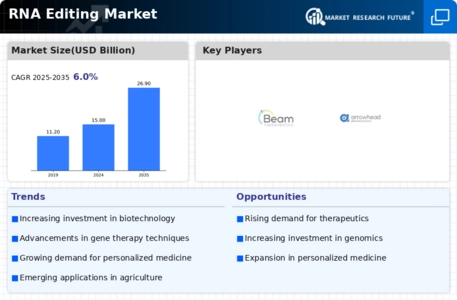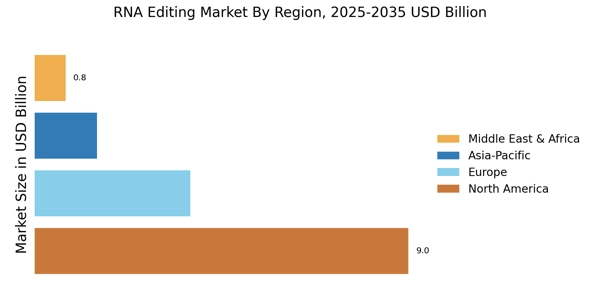Advancements in CRISPR Technology
The RNA Editing Market is significantly influenced by advancements in CRISPR technology. CRISPR-Cas9 and related systems have revolutionized genetic engineering, enabling precise modifications to RNA sequences. These advancements not only enhance the efficiency of RNA editing but also expand its applications in various fields, including therapeutics and agriculture. The market for CRISPR-based solutions is projected to reach several billion dollars in the coming years, indicating a robust interest in RNA editing technologies. As researchers continue to explore the potential of CRISPR for RNA editing, the industry is likely to witness increased collaboration between academic institutions and biotechnology companies, further propelling growth in the RNA Editing Market.
Rising Prevalence of Genetic Disorders
The RNA Editing Market is experiencing growth due to the increasing prevalence of genetic disorders. As more individuals are diagnosed with conditions such as cystic fibrosis and muscular dystrophy, the demand for innovative therapeutic solutions rises. RNA editing technologies offer potential treatments that can correct genetic mutations at the RNA level, thereby addressing the root cause of these disorders. According to recent estimates, genetic disorders affect approximately 1 in 10 individuals, highlighting a substantial patient population that could benefit from RNA editing therapies. This growing need for effective treatments is likely to drive investments and research in the RNA Editing Market, fostering advancements in technology and therapeutic applications.
Growing Interest in RNA-Based Therapeutics
The RNA Editing Market is benefiting from the growing interest in RNA-based therapeutics. With the rise of mRNA vaccines and therapies, there is a heightened awareness of the potential of RNA as a therapeutic target. This trend is leading to increased funding and research initiatives focused on RNA editing technologies. The market for RNA therapeutics is expected to surpass several billion dollars by the end of the decade, driven by the need for innovative treatments for various diseases. As pharmaceutical companies invest in RNA editing solutions, the RNA Editing Market is poised for significant expansion, with a focus on developing novel therapies that leverage RNA editing capabilities.
Regulatory Support for Gene Editing Technologies
The RNA Editing Market is experiencing favorable conditions due to regulatory support for gene editing technologies. Governments and regulatory bodies are increasingly recognizing the potential of RNA editing as a transformative approach to treating genetic diseases. This support is manifested in streamlined approval processes and funding for research initiatives. As regulatory frameworks evolve to accommodate innovative therapies, the RNA Editing Market is likely to see accelerated development and commercialization of RNA editing products. The positive regulatory environment encourages investment and collaboration among stakeholders, fostering a robust ecosystem for RNA editing technologies.
Increased Collaboration Between Academia and Industry
The RNA Editing Market is witnessing increased collaboration between academic institutions and industry players. This trend is driven by the need for innovative solutions to complex genetic disorders and the potential of RNA editing technologies. Collaborative efforts often lead to the sharing of resources, expertise, and funding, which can significantly enhance research outcomes. As partnerships between universities and biotechnology firms grow, the RNA Editing Market is likely to benefit from accelerated advancements in technology and therapeutic applications. These collaborations may also facilitate the translation of research findings into viable products, further propelling the growth of the RNA Editing Market.


















Leave a Comment